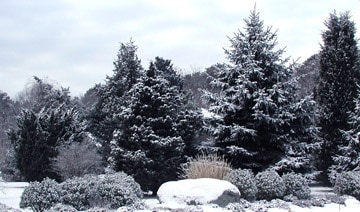“I need some evergreens!” an almost panicked woman recently said to me. “They’re building on the lot next door, and they’ve cut down all the trees!”
Like many people in this situation, my customer was interested in buying several tall evergreens. She wanted to plant a long row of them to block the construction. I agreed that a screen was needed, but I wondered if it was wise to choose only one type of evergreen.
I told her to imagine her screen eight years from now, when it had grown tall and thick. Then I asked her how it would look if two or three of those tall plants died. “It would be terrible… I’d have to replant the ones that died.” She replied. I pointed out that in replacing them she would have to find mature plants that were exactly the same. “What if you can’t find plants that are identical in variety and size?” I said. “Other choices will look odd because they won’t match.”
Finding the right replacement for a dead section is only one problem. Using one type of plant also puts the entire row at risk if an insect or disease comes along. Such a “mono-culture” is always vulnerable to the next pest that comes into an area.
As an alternative, a screening of mixed evergreens provides an attractive mix of leaf colors and textures. If one of the plants becomes prone to damage by insects or disease, you are less likely to lose the rest of the shrubbery. And replacement plants won’t look out of place if the original plant selection was diverse.
Finally, I explained to my customer that the birds and wildlife also appreciate an assortment. “That seals it!” she said, “The more the merrier!” And she herself was quite merry as she went out to select her shrubs.
Good fences might make good neighbors, but diverse plantings definitely make good screens.

